Watch all the Transform 2020 sessions on-demand here.
In May 2018, Uber announced it wouldn’t renew its permit to test self-driving vehicles in California, citing caution in the wake of a fatal accident involving one of its autonomous cars in Arizona. (The California Department of Motor Vehicles requires that companies apply to test autonomous cars in the state.) But in a bid to close the gap with rivals including GM’s Cruise Automation and Alphabet’s Waymo, Uber recently reapplied for a permit, which was granted early this morning.
Uber announced that it’s been added to the list of approved testers through the California Department of Motor Vehicles. The company cautions that it doesn’t have immediate plans to engage in autonomous driving, although it’s eyeing San Francisco as a potential site. Instead, it’ll kick off driving with trained drivers behind the wheel and notify local, state, and federal stakeholders prior to launching driverless tests.
“San Francisco is a great city to gather key learnings for self-driving technology given it’s complex and ever-changing environment,” Uber spokesperson Sarah Abboud told VentureBeat via email. “While we do not have an update as to exactly when we’ll resume autonomous testing, receiving our testing permit through the California DMV is a critical step towards that end in Uber’s home city.”
About 65 companies have the DMV’s go-ahead to test self-driving vehicles on public California roads, which is different than the permits issued by the California Public Utilities Commission (CPUC) to transport passengers in autonomous vehicles. Only five companies — Aurora, AutoX, Pony.ai, Waymo, and Zoox — have permits under the CPUC’s pilot program, with Zoox being the first to receive one in December 2018.
June 5th: The AI Audit in NYC
Join us next week in NYC to engage with top executive leaders, delving into strategies for auditing AI models to ensure fairness, optimal performance, and ethical compliance across diverse organizations. Secure your attendance for this exclusive invite-only event.
A bumpy road toward autonomy
In an S-1 filing ahead of its initial public offering, Uber noted that ATG has grown from a team of 40 Pittsburgh-based researchers in 2015 to a 1,000-person workforce spread across offices in San Francisco and elsewhere. Furthermore, it said that it’s collected data from “millions” of autonomous vehicle testing miles to date and completed “tens of thousands” of passenger trips to date. And it’s gathering map data in Washington D.C., San Francisco, Dallas, and Toronto.
Looking ahead, Uber expects that cars like those it’s currently testing will replace drivers in some situations, but not right away. Instead, it’s predicting a “long period of hybrid autonomy” in which autonomous vehicles are deployed “gradually” against specific use cases — for instance, in scenarios involving substantial traffic, complex routes, or unusual weather, or during “high-demand events” such as concerts or sporting events.
But Uber has a mixed track record when it comes to self-driving car research. It restarted tests of its cars in Pittsburgh last December, after which it began manual tests in San Francisco and Toronto. The National Transportation Safety Board later determined that Uber had disabled the automatic emergency braking system in the Volvo XC90 involved in the aforementioned crash. (The company said in internal documents that this was to “reduce the potential for erratic vehicle behavior.”)
Uber said it’s taken a number of steps to improve its safety program In the years since the crash, informed by an independent external review conducted by law firm LeClairRyan and an internal review.
The company raised the technical competency required for operator roles and added Commercial Driver’s License-level medical fitness requirements. It also increased training on defensive driving, distracted driving, fatigue, system capabilities, failure modes, and policies, and it imposed a rule requiring that at least two in-car safety operators be present during testing.
Now, operators are limited to four hours behind the wheel in a workday and two hours without taking a break or switching positions. They’re additionally subject to monitoring by a camera system that detects when they might be distracted and sounds an audible alert before sending a notification to a remote monitoring team for review.
On the technical side, Uber said it implemented modifications to improve detection and tracking of pedestrian and cyclists, and it said it implemented modifications to its cars’ emergency braking systems to enable simultaneous operation with its self-driving technology. The in-cabin touchscreen software was refreshed with an interface that minimizes distraction and warns of excess speed during manual driving. And Uber established both an independent panel charged with suggesting changes to its self-driving program and a separate operational safety and systems engineering and testing teams.
Uber’s public relations battle hasn’t lessened in intensity, though. In a recent study conducted by U.K. firm Leasing Options, only 6% of the 1,000 people surveyed indicated that they trusted a taxi company such as Uber or Lyft to produce a self-driving car. That’s compared with the 62.6% who said they’d trust an automaker over a tech company.


